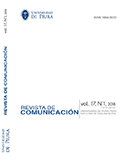
Artículo
Engagement estratégico y encuentro conversacional en los medios sociales
Bibliografía
Anderson, M. y Caumont, A. (24 de septiembre de 2014). How social media is reshaping news [Pew Research Center]. Recuperado de: http://www.pewresearch.org/fact-tank/2014/09/24/how-social-media-is-reshaping-news/
Arata, G. (2014). Enti local e social network. Il Mulino, 2, 323-328.
Ashley, Ch. y Tuten, T. (2015). Creative Strategies in Social Media Marketing: An Exploratory Study of Branded Social Content and Consumer Engagement. Psychology & Marketing, 32 (1), 15-27. Recuperado de: http://tracytuten.com/wp-content/uploads/2016/03/Ashley_et_al-2015-Psychology__Marketing.pdf
Barbrook, R. y Cameron, A. (1996). The Californian ideology. Science as Culture, 1, 44-72. Recuperado de: http://www.comune.torino.it/gioart/big/bigguest/riflessioni/californian_engl.pdf
Bhattacharya, S., Srinivasan, P., y Polgreen, Ph. (2017). Social media engagement analysis of U.S. Federal health agencies on Facebook. BMC Medical Informatics and Decision Making, 17:49.
Bowman, S. y Willis, CH. (2003). We Media: How audiences are shaping the future of news and information. The Media Center at The American Press Institute. Recuperado de: http://www.hypergene.net/wemedia/download/we_media.pdf
Buber, M. (2006). Yo y Tú. Buenos Aires: Lilmod.
Castells, M. (2009). Comunicación y poder. Madrid: Alianza.
Chandler, D. y Munday, R. (2016). A Dictionary of Social Media. Oxford: Oxford University Press.
Cogo, G. (2012). I social network nella PA. Santarcangelo di Romagna: Maggioli.
Dessart, L., Veloutsou, C. y Morgan-Thomas, A. (2015). Consumer engagement in online brand communities: a social media perspective. Journal of Product & Brand Management, 24 (1), 28-42. Recuperado de: http://www.emeraldinsight.com/doi/pdfplus/10.1108/JPBM-06-2014-0635
Evans, D. (2010). Social Media Marketing: the next generation of business engagement. Indianapolis: Wiley.
Fernández, A. (4 de enero de 2017). Cómo calcular el engagement en social media [SocialMedier]. Recuperado de: http://socialmedier.com/formula-engagement-calcular-engagement-rate-formula/
Gadamer, H.G. (1997). Verdad y método. Salamanca: Sígueme.
Garst, K. (10 de mayo de 2014). Social Media Measurement and the Only Metric That Matters [Huffingtonpost]. Recuperado de: http://www.huffingtonpost.com/kim-garst/social-media-measurement-_b_4910702.html
Gillmor, D. (2004). We the Media: Grassroots Journalism by the People, for the People. O’Reilly Media.
Global Web Index (2017). Quarterly report on the latest trends in social networking. Recuperado de: http://insight.globalwebindex.net/hubfs/Reports/Social-Q1-2017/GWI-Social-Summary-Q1-2017.pdf?t=1498575132979
Goodman, G.F. (2012). Engagement Marketing: How Small Business Wins in a Socially Connected World. Nueva Jersey: Wiley.
Habermas, J. (1987). Teoría de la acción comunicativa. Taurus: Madrid.
Harden, L. y Heyman, B. (2009). Digital Engagement: Internet Marketing That Captures Customers and Builds Intense Brand Loyalty. Nueva York: American Management Association.
Human Level Communications. Engagement. En Diccionario de Marketing Online. Recuperado de: https://www.humanlevel.com/diccionario-marketing-online/engagement
Jenkins, H. (2008). Convergence Culture. La cultura de la convergencia de los medios de comunicación. Barcelona: Paidós.
Kaushik, A. (10 de octubre de 2011). Best Social Media Metrics: Conversation, Amplification, Applause, Economic Value [Occam’s Razor]. Recuperado de: https://www.kaushik.net/avinash/best-social-media-metrics-conversation-amplification-applause-economic-value/
King, K. (2008). Journalism as a Conversation. Nieman Reports, 62 (4), 11-13. Recuperado de: http://niemanreports.org/articles/journalism-as-a-conversation-2/
Kunelius, R. (2001). Conversation: a metaphor and a method for better journalism? Journalism Studies, 2 (1), 31-54.
Lee, D., Hosanagar, K. y Nair, H. (2015). Advertising Content and Consumer Engagement on Social Media: Evidence from Facebook. Working Paper No. 3087, Graduate School of Business, Stanford. Recuperado de: https://www.gsb.stanford.edu/faculty-research/working-papers/advertising-content-consumer-engagement-social-media-evidence
Levine, R., Locke, Ch., Searls, D. y Weinberger, D. (1999). Clutrain manifesto. Recuperado de: http://tremendo.com/cluetrain/
Magnani, E. (2014). Tensión en la red: libertad y control en la era digital. Buenos Aires: Autoría.
Marchionni, D. M. (2013). Journalism as a Conversation: A Concept Explication. Communication Theory, 23 (2), 131-147.
McCay-Peet, L. y Quan-Haase, A. (2016). A Model of Social Media Engagement: User Profiles, Gratifications, and Experiences. En O’Brien, H. y Cairns, P. (Eds.). Why Engagement Matters: Cross-Disciplinary Perspectives of User Engagement in Digital Media (199-217). Cham, Nueva York: Springer.
McLuhan, M. (1964). Understanding media: the extensions of man. Nueva York: McGraw-Hill.
Negroponte, N. (1995). Being digital. Nueva York: Knopf.
Núñez, V. (17 de enero de 2017). Fórmulas para calcular el engagement en redes sociales y el CTR de tus publicaciones [Vilma Núñez]. Recuperado de: https://vilmanunez.com/formula-engagement-redes-sociales-ctr/
Origami Logic (2016). The Marketer’s Guide to Measuring Social Engagement. Recuperado de: https://resources.origamilogic.com/ebooks/the-marketers-guide-to-measuring-social-engagement.
Raso, A. (28 de marzo de 2016). How to Measure Engagement the Right Way [Content Marketing Institute]. Recuperado de: http://contentmarketinginstitute.com/2016/03/measure-engagement-right/
Sacks, H., Schegloff, E. A., y Jefferson, J. (1974). A simplest systematics for the organization of turn- taking for conversation. Language, 4, 696-735.
Schivinski, B, Christodoulides, G. y Dabrowski, D. (2016). Measuring Consumers’ Engagement with Brand-Related Social-Media Content. Journal of Advertising Research, 56 (1), 64-80.
Silverman, J. (2005). Terms of service: social media and the price of constant connection. Nueva York: HarperCollins.
Sorice, M. (2009). Sociologia dei mass media. Roma: Carocci.
Stati, S. (1982). Il dialogo: considerazioni di linguistica pragmática. Nápoles: Liguori.
Statista (2017). Global social network penetration rate. Recuperado de: https://www.statista.com/statistics/269615/social-network-penetration-by-region/
Syrdal, HA. y Briggs, E. (2016). Developing a Positive Organizational Image: The Role of Engagement with Social Media Content. SMA Proceedings, 74-83. Recuperado de: http://c.ymcdn.com/sites/www.marketingadvances.org/resource/resmgr/Proceedings/SMA2016_v11.pdf#page=74
Taylor, M. y Kent, M.L. (2014). Dialogic Engagement: Clarifying Foundational Concepts. Journal of Public Relations Research, 26 (5), 384-398.
Ure, M. y Parselis, M. (2013). Argentine Media and Journalists Enhancing and Polluting of Communication on Twitter. International Journal of Communication, 7, 2013, Feature 1784–1800. Recuperado de: http://ijoc.org/index.php/ijoc/article/view/2178/970
Ure, M. (2016). La comunicación de la administración pública en las redes sociales: los casos de las ciudades de Buenos Aires y Bolonia. Palabra Clave, 1, 240-270. Recuperado de: http://palabraclave.unisabana.edu.co/index.php/palabraclave/article/view/5156/pdf
Van Dijck, J. (2016). La cultura de la conectividad: una historia crítica de las redes sociales. Buenos Aires: Siglo Veintiuno.
Wiener, N. (1949). Cybernetics: or, Control and communication in the animal and the machine. Nueva York: Wiley.
Wolton, D. (2010). Informar no es comunicar. Barcelona: Gedisa.
